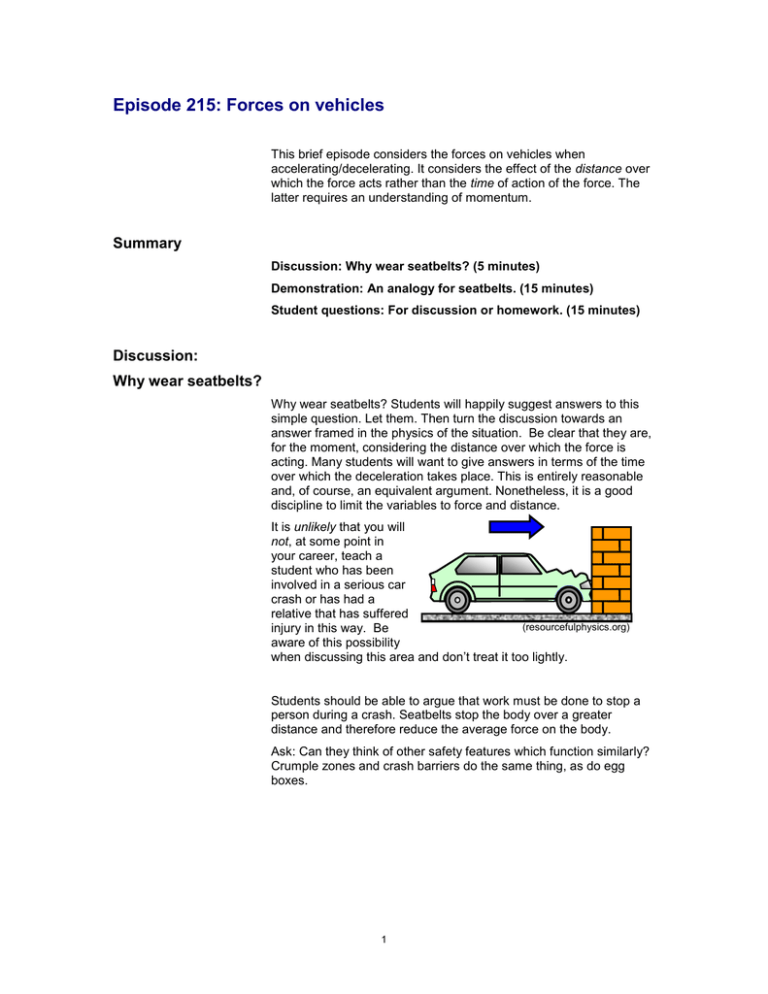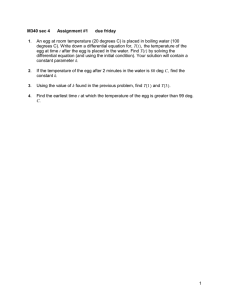Episode 215: Forces on vehicles (Word, 83 KB)
advertisement

Episode 215: Forces on vehicles This brief episode considers the forces on vehicles when accelerating/decelerating. It considers the effect of the distance over which the force acts rather than the time of action of the force. The latter requires an understanding of momentum. Summary Discussion: Why wear seatbelts? (5 minutes) Demonstration: An analogy for seatbelts. (15 minutes) Student questions: For discussion or homework. (15 minutes) Discussion: Why wear seatbelts? Why wear seatbelts? Students will happily suggest answers to this simple question. Let them. Then turn the discussion towards an answer framed in the physics of the situation. Be clear that they are, for the moment, considering the distance over which the force is acting. Many students will want to give answers in terms of the time over which the deceleration takes place. This is entirely reasonable and, of course, an equivalent argument. Nonetheless, it is a good discipline to limit the variables to force and distance. It is unlikely that you will not, at some point in your career, teach a student who has been involved in a serious car crash or has had a relative that has suffered (resourcefulphysics.org) injury in this way. Be aware of this possibility when discussing this area and don’t treat it too lightly. Students should be able to argue that work must be done to stop a person during a crash. Seatbelts stop the body over a greater distance and therefore reduce the average force on the body. Ask: Can they think of other safety features which function similarly? Crumple zones and crash barriers do the same thing, as do egg boxes. 1 Demonstration: Why wear seatbelts? An analogy for seatbelts A diverting demonstration that highlights the issues raised in the discussion. It is worthwhile putting in a few numbers to get a feel for the force on the egg as it breaks. A scheme for such a calculation is suggested in the experimental description. This can be compared to the force required to crack an egg by adding newton weights to it. The force the egg experienced in the crash will have been many times the weight of the egg. Similarly, the force on a crash victim can be much higher than body weight. TAP 215-1: Why wear seatbelts? Student questions: For discussion or homework These questions cover similar ground to those in the previous episode but focus on the application of W = Fs to car safety. TAP 215-2: Forces and car safety 2 TAP 215-1: Why wear seatbelts? Apparatus dynamics trolley with spring plunger 2 eggs wall seat for egg (cut from egg box) adhesive tape (for seatbelt) Propel an egg mounted on its seat towards a steady wall. When the trolley strikes the wall it will slow down over a distance of a centimetre or two because the spring plunger acts a little like a crumple zone. Inertia will carry the egg forward until it strikes the wall and stops over a short distance. This should dramatically break the egg. Repeat the process with a new egg harnessed to the seat. This one should survive. 3 Estimation of force on egg Mass of egg: = …………kg Weight of egg = ………………..N Velocity of egg before impact = ………….m s-1 Distance over which deceleration occurs (about half an egg width) ………….. m = initial kinetic energy – final kinetic Work done energy = initial kinetic energy – 0 = …………………… J Force N = work done/ distance Force on egg = 4 = ……………………….. ……… weight of egg External references This activity is taken from Resourceful Physics http://resourcefulphysics.org/ 5 TAP 215- 2: Forces and car safety 1. Explain the effects below using the concept work done = force distance. Eggs dropped from 10 cm onto a hard floor do not always crack but eggs dropped from 1 m onto the same floor will always crack. Air bags in cars help prevent head injuries. Air bags increase the area over which the force acts, as well as increasing the distance to come to rest. Cars have crumple zones which help to protect passengers in a crash. Crash barriers beside a main road are fairly easy to deform. 2. In a crash test, a dummy is thrown against an air bag at 5 m s -1. The dummy is decelerated to 0 m s-1 over a distance of 0.2 m. The mass of the dummy is 60 kg. (a) Calculate the original kinetic energy of the dummy. (b) Calculate the average force on the dummy during deceleration. (c) Explain why your calculation gives the average force. (d) Explain why you would expect a more massive dummy to deform the air bag more than 0.2 m. 6 Answers and worked solutions 1 (a) Stopping distance is the same in both cases but the force will be ten times as great when dropped from ten times the height as: GPE = mgh mgh = F x d so F = mgh/d Longer braking distance so average force decreased. Longer braking distance decreases average force (& crumpling absorbs energy). They are designed to crumple to lower average force and absorb energy. 2 (a) 750 J (b) 3750 N (c) e.g. The force on the dummy will change as the pressure exerted by the airbag increases, then decreases. (d) If the original velocity is the same the kinetic energy will be greater hence more work needs to be done. 7





